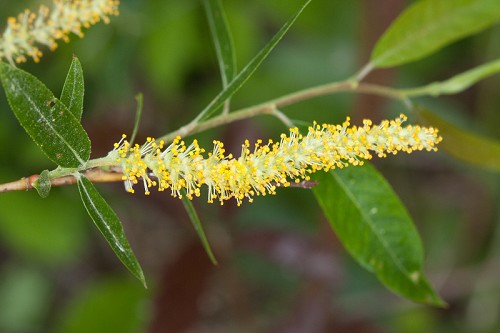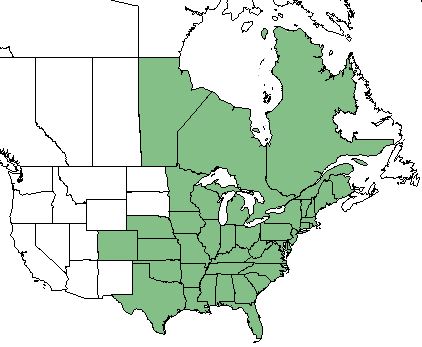Salix nigra
Common names: black willow[1]
| Salix nigra | |
|---|---|

| |
| Photo by John Gwaltney hosted at Southeastern Flora.com | |
| Scientific classification | |
| Kingdom: | Plantae |
| Division: | Magnoliophyta - Flowering plants |
| Class: | Magnoliopsida - Dicots |
| Order: | Salicales |
| Family: | Salicaceae |
| Genus: | Salix |
| Species: | s. nigra |
| Binomial name | |
| Salix nigra Marshall | |

| |
| Natural range of Salix nigra from USDA NRCS Plants Database. | |
Contents
Taxonomic Notes
Synonym: S. marginata (Wimmers ex Andersson)
Variety: none
Description
Synonym: S. nigra is a perennial tree of the Salicaceae family that is native to North America.[1]
Distribution
S. nigra is found throughout the eastern United States and Canada, as far west as Texas, Colorado, and Manitoba.[1]
Ecology
Habitat
Moist environments such as stream banks, lakes, swamps, or pasture sloughs are ideal for S. nigra.[1] Specimens have been collected from wet woodland, river banks, soil around ponds, swamps, floodplain woodland, coastal hammock, and lake shores.[2]
Phenology
S. nigra has been observed to flower March through May with peak inflorescence in April.[1][3]
Seed dispersal
Seeds are commonly dispersed by wind and water.[1]
Fire ecology
Fires are not common to the native habitats of S nigra and can be devastating when they occur, killing the entire population in some cases, especially young seedlings.[1] Despite this, populations have been known to survive repeated annual burning on the Wade Tract in south Georgia.[4]
Pollination
Bees utilize the plant for its nectar and pollen.
Herbivory and toxicology
Domestic animals or livestock will use it for grazing. Elk and beavers will use it for browse in the summer. Beavers, hares, and rabbits will eat the shoots. The willow is also a host for butterflies. [1] S. nigra is visited by ground-nesting bees from the Andrenidae family (Andrena andrenoides, A. atlantica, A. bisalicis, A. cressonii, A. forbesii, A. hippotes and A. semipunctata) and long-tongued bees from the Apidae family such as Ceratina calcarata.[5] S. nigra has also been observed to host aphids from the Aphididae family (Aphis sp. and Tuberolachnus salignus), leafhoppers from the Cicadellidae family such as Idiocerus sp., negro bugs from the family Cydnidae such as Sehirus cinctus, planthoppers from the Delphacidae family such as Delphacodes puella, leafcutting bees from the Megachilidae family such as Osmia lignaria, treehoppers from the Membracidae family such as Micrutalis calva, plant bugs from the Miridae family such as Phytocoris sp., Plagiognathus tinctus and Plagiognathus atricornis, and prominent moths from the Notodontidae family such as Furcula cinerea.[6]
Diseases and parasites
Many insects are pests for the S. nigra; including forest tent caterpillar, gypsy moth, cotton wood leaf beetle, and willow beetle which can inhibit growth. Others such as stem borers will attack the base of the plant, killing it, or twig borers which will cause branch deformities. [1]
Diseases are brought to the species due to the pest insects that are common to the S. nigra. Diseases include willow blight that cause leaves and stems to die due to the fungus. Phytophthora cactorum is a canker that can cause lesions of the stalks. Cytospora chrysosperma can also cause cankers. [1]
Conservation, cultivation, and restoration
Salix nigra can be used as a soil binder when it grows along the banks of streams which helps soil from being washed away and prevent erosion. [1]
In order to flourish S. nigra needs to be thinned periodically or it will not be able to spread and grow. [1]
Cultural use
Historically, native peoples would use a bark tea to treat lumbago, colds, asthma, indigestion, diarrhea, ulcers, and gangrene. It was also believed that the catkins was an aphrodisiac.[7]
Photo Gallery
References and notes
- ↑ 1.00 1.01 1.02 1.03 1.04 1.05 1.06 1.07 1.08 1.09 1.10 1.11 USDA Plant Database
- ↑ URL: http://herbarium.bio.fsu.edu. Last accessed: June 2018. Collectors: R. K. Godfrey, H. Kurz, Gary Knight, Angus Gholson, Loran C. Anderson, D.B, Ward, P.L. Redfearn, R. Komarek, Brian R. Keener, Tracy Duckworth. States and counties: Florida (Holmes, Gadsden, Jackson, Washington, Madison, Leon, Walton, Franklin, Gulf, Okaloosa, Escambia, Wakulla) Georgia (Seminole, Decatur, Thomas) Alabama (Dallas)
- ↑ Nelson, G. PanFlora: Plant data for the eastern United States with emphasis on the Southeastern Coastal Plains, Florida, and the Florida Panhandle. www.gilnelson.com/PanFlora/ Accessed: 29 MAY 2018
- ↑ Platt, W.J., R. Carter, G. Nelson, W. Baker, S. Hermann, J. Kane, L. Anderson, M. Smith, K. Robertson. 2021. Unpublished species list of Wade Tract old-growth longleaf pine savanna, Thomasville, Georgia.
- ↑ Discoverlife.org [1]
- ↑ Discoverlife.org [2]
- ↑ Korchmal, Arnold & Connie. 1973. A Guide to the Medicinal Plants of the United States. The New York Times Book Company, New York.